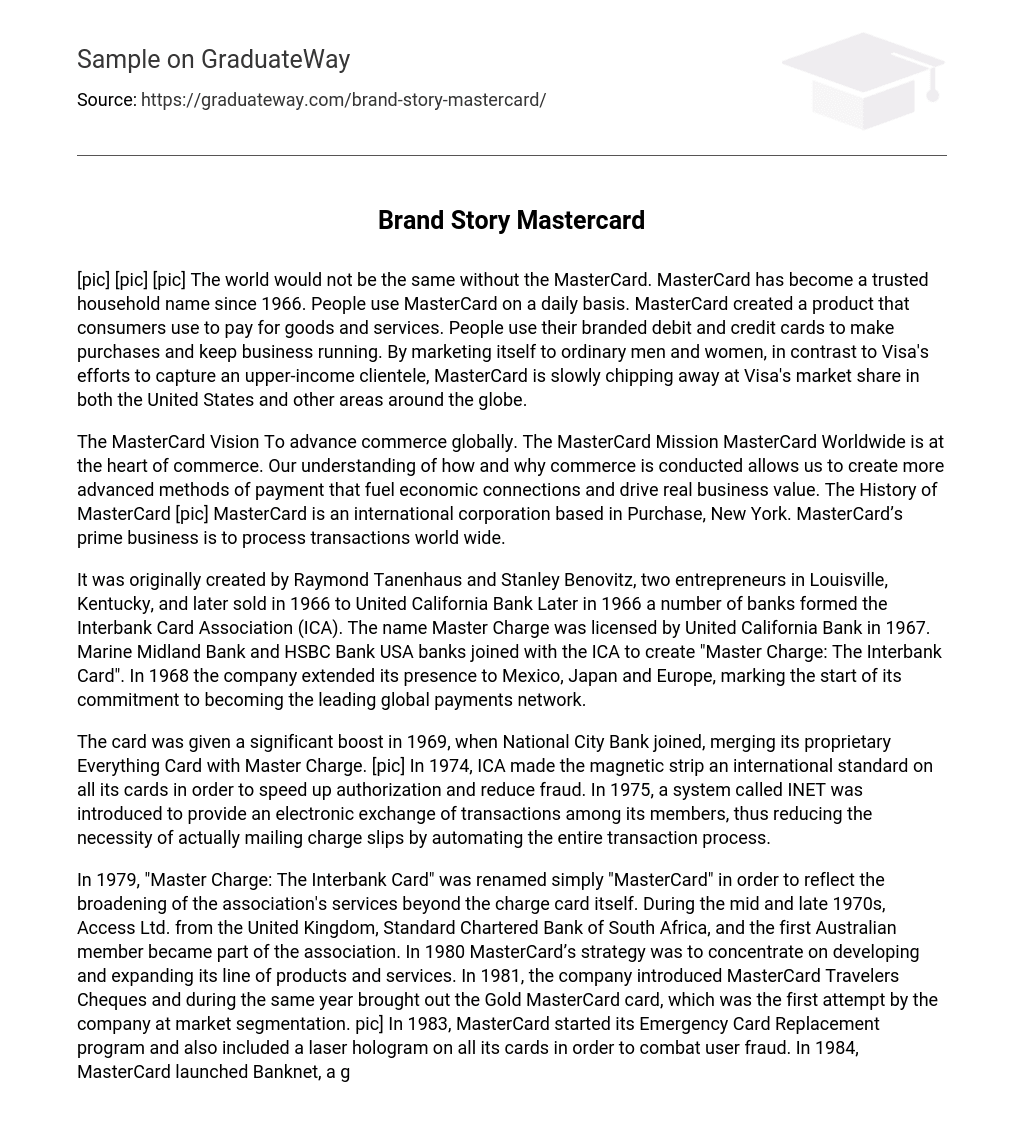The world would not be the same without the MasterCard. MasterCard has become a trusted household name since 1966. People use MasterCard on a daily basis. MasterCard created a product that consumers use to pay for goods and services. People use their branded debit and credit cards to make purchases and keep business running. By marketing itself to ordinary men and women, in contrast to Visa’s efforts to capture an upper-income clientele, MasterCard is slowly chipping away at Visa’s market share in both the United States and other areas around the globe.
The MasterCard Vision To advance commerce globally. The MasterCard Mission MasterCard Worldwide is at the heart of commerce. Our understanding of how and why commerce is conducted allows us to create more advanced methods of payment that fuel economic connections and drive real business value.
MasterCard is an international corporation based in Purchase, New York. MasterCard’s prime business is to process transactions world wide. It was originally created by Raymond Tanenhaus and Stanley Benovitz, two entrepreneurs in Louisville, Kentucky, and later sold in 1966 to United California Bank Later in 1966 a number of banks formed the Interbank Card Association (ICA). The name Master Charge was licensed by United California Bank in 1967. Marine Midland Bank and HSBC Bank USA banks joined with the ICA to create “Master Charge: The Interbank Card”. In 1968 the company extended its presence to Mexico, Japan and Europe, marking the start of its commitment to becoming the leading global payments network.
The card was given a significant boost in 1969, when National City Bank joined, merging its proprietary Everything Card with Master Charge. In 1974, ICA made the magnetic strip an international standard on all its cards in order to speed up authorization and reduce fraud. In 1975, a system called INET was introduced to provide an electronic exchange of transactions among its members, thus reducing the necessity of actually mailing charge slips by automating the entire transaction process.
In 1979, “Master Charge: The Interbank Card” was renamed simply “MasterCard” in order to reflect the broadening of the association’s services beyond the charge card itself. During the mid and late 1970s, Access Ltd. from the United Kingdom, Standard Chartered Bank of South Africa, and the first Australian member became part of the association.
In 1980 MasterCard’s strategy was to concentrate on developing and expanding its line of products and services. In 1981, the company introduced MasterCard Travelers Cheques and during the same year brought out the Gold MasterCard card, which was the first attempt by the company at market segmentation.
In 1983, MasterCard started its Emergency Card Replacement program and also included a laser hologram on all its cards in order to combat user fraud. In 1984, MasterCard launched Banknet, a global packet-switching network that enables its international card acceptance locations to authorize transactions. MasterCard also implemented an automated point-of-sale program to improve its authorization system worldwide. In 1986, a MasterCard office was opened in Hong Kong, the first in the Pacific Rim region, and one year later MasterCard arranged to become the first credit card issued in the People’s Republic of China.
During this time, the company opened a regional office for Latin America in Miami. In 1988, MasterCard acquires the Cirrus® ATM network In 1990, MasterCard unveils a co-branding strategy and becomes the industry’s co-branding leader. In 1991, Europay and MasterCard launch Maestro®, the world’s first online point-of-sale debit network.
With its aggressive advertising campaign starting in 1991, MasterCard is determined to create a higher profile for itself and, in turn, a larger share of credit card billings around the world. Sponsorship of the World Cup in 1994 includes sponsoring 269 matches between 1991 and 1994, which contributed to an increased recognition of MasterCard’s name and services.
MasterCard’s renowned advertising slogan Priceless was launched. It is virtually impossible to turn on a TV and not see a commercial with this saying in it. This slogan has become a popular term in the world of MasterCard. This slogan was introduces in 1997. The slogan associated with the campaign is “There are some things money can’t buy. For everything else, there’s MasterCard. ”
In 2001, Launch of MasterCard Advisors professional services, the largest global consultancy focused on the payments industry. In 2002, MasterCard merged with Europay International to create MasterCard International—one worldwide company with one management team and converts to a private-share corporation in June 2002. MasterCard was in the best position to achieve its goals as an industry leader and to help the company’s customers achieve profitable growth. MasterCard launched and completed initial trial of its MasterCard PayPass™ contactless payment program in Orlando, Florida, with Chase, Citibank and MBNA.
The year of 2006 was a busy year for the history of MasterCard. MasterCard changed to a different ownership structure. They began trading on the New York stock exchange. MasterCard managed to raise the largest United States stock sale in two years. In 2006, MasterCard introduces new corporate name, MasterCard Worldwide, and adopts a new corporate signature and tagline, The Heart of Commerce™, to reflect the company’s globally integrated structure and strategic vision of advancing commerce worldwide.
In 2007, MasterCard Worldwide launched knowledge leadership initiative with the Worldwide Centers of Commerce. In 2008, MasterCard saw double digit revenue growth. This was one of the best years in MasterCard history. There companies’ revenue was expected to double again over the upcoming years. It is hard to imagine daily life without MasterCard being part of society. This company has brought about a new and innovative way to pay for goods and services. MasterCard credit and debit cards can be easily obtained for daily use.





